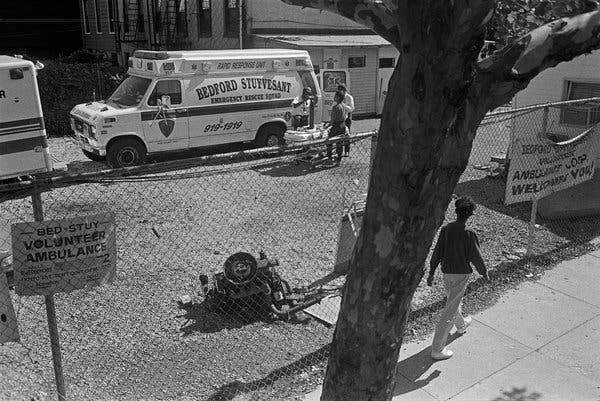When a 7-year-old girl was hit by a car one day in 1988 in the Bedford-Stuyvesant section of Brooklyn, it took more than 30 minutes for an ambulance to arrive. When it did, her uncle, James Robinson Jr., climbed in for the ride to the hospital.
The ambulance was equipped with lifesaving equipment, he said, but “the attendant didn’t even know how to turn on the oxygen.” His niece, Cynthia Lomax, died along the way.
The incident prompted Mr. Robinson to start a volunteer ambulance corps in Bedford-Stuyvesant that has answered calls ever since, cutting response times to only a few minutes. The group, one of more than 30 volunteer emergency service agencies in New York City today and one of nearly that many certified to give basic life support, has also trained more than 1,000 emergency medical technicians.
Mr. Robinson, who was known as Rocky, died on Friday at 79. The cause was heart failure, said a son, Antoine Robinson.
When he started the corps, Mr. Robinson had a day job that made him well aware of a devastating crack epidemic that was ravaging poor and working-class neighborhoods in New York City: He was an ambulance driver for the Emergency Medical Service of the New York City Health and Hospitals Corporation.
Mr. Robinson said his mission with the corps was not to replace E.M.S. but to add to the ranks of those qualified to help in emergencies. “They never thought black guys would want to save lives,” he said in an interview with The New York Times in 2017, without specifying who “they” were. “It’s about neighbor helping neighbor. I don’t see the color of the skin.”
The corps trained volunteers — young people Mr. Robinson affectionately called “vollies” — to be emergency medical technicians. Once they passed state examinations, the volunteers could take a patient to a hospital and provide basic first aid along the way.
At first he and a friend with whom he started the corps listened to police and fire department radios and went to addresses they heard on the air — accident scenes or apartments where sick people needed help. They answered the calls in their own cars.
Before long they got an ambulance, the first of several that the corps would operate. Mr. Robinson recalled in 2017 that on the first day with the first ambulance, the corps treated 10 people at the scene of a fire. On the second day, corps members delivered a baby.
Dr. Alexander E. Kuehl, who was the medical director of the city’s Emergency Medical Service and a vice president of the Health and Hospitals Corporation when the corps began, said in 2017 that the corps had opened a pathway to E.M.S.

“That was the catch about E.M.S. when I got there: You had to have a driver’s license and your E.M.T. card to join E.M.S.,” Dr. Kuehl said. “I needed to have a way for ghetto kids to get that card like the kids on suburban Long Island” — where volunteer fire departments are entrenched in many towns and villages — and provide training.
Over the years, the corps became something of a labor of love, with protégés teaching classes for those seeking to join the ranks. “The corps, we don’t get much money,” Mr. Robinson’s son Reggie said in 2017, “and he couldn’t afford to give me a salary. A lot of times, that place runs off of Pop’s pension.”
Mr. Robinson retired from E.M.S. in 2000 with the rank of captain but continued to oversee the corps, which is still in operation.
In addition to his sons Antoine and Reggie, his survivors include his wife, Vernice, and many other children.
At one point Mr. Robinson underwent a kidney transplant, and the donor was an adopted son who was part of the corps. In 2017 he was injured at the West Indian-American Day Parade, a Labor Day celebration in Brooklyn that has often been marred by violence. When a 22-year-old man was hit by gunfire on a side street, the crowd surged toward where Mr. Robinson, by then in a wheelchair, had positioned himself.
“Guess who they trampled?” Mr. Robinson said. “Me. They were waving ‘Rocky! Rocky!’ They all know me. I was trying to get people to save lives and nearly lost mine. Instead of running to me for help, they trampled me. They crushed the whole foot.” It had to be amputated.
James Matthew Robinson Jr. was born on July 15, 1940, in Marietta, N.C. His parents moved to Brooklyn when he was a child. He graduated from Eastern District High School in the Williamsburg section and joined the Army. He served in the 3rd U.S. Infantry Regiment, known as the Old Guard, and Mr. Robinson often recalled standing guard when Jacqueline Kennedy visited President John F. Kennedy’s grave at Arlington National Cemetery.
Back in Brooklyn after the Army, Mr. Robinson sometimes needed urgent medical help himself — even before the West Indian parade incident. Once, in 1992, he went into cardiac arrest. The emergency team that was dispatched included several people he had helped train.
Antoine Robinson said that in the emergency room his father was treated by one Dr. Timothy Sutton. Dr. Sutton had been in the corps’ first class and had later gone to medical school.

